
21 minute read
The Holy Grail
Written by Pete Williams from The Soil Association
Advertisement
A team of six farmers is trialling growing a living mulch under cash crops – if they’re successful, they say the practice could eliminate the need for artificial inputs, cut costs and boost productivity. The group is aiming to discover whether cash crops can be successfully grown in a permanent clover understory (living mulch) to control weeds and fix nitrogen. A key question is whether this can be achieved without significantly affecting yields. The farmers say that if successful, what they discover could be the ‘holy grail’ for arable farming, offering a way to build fertility without livestock, tillage or synthetic inputs, while sequestering more carbon, cutting costs, and improving productivity.
Both conventional and organic farmers are involved in the trial and are pooling findings and knowledge. The trial is part of the living mulch field lab being run through the Innovative Farmers programme with the support of AHDB, Organic Research Centre and Organic Arable. “There are two starting points of the group,” says Dominic Amos, who is one of the researchers in field lab and senior crops researcher at ORC. “Some are already practising long term conventional no-till and are looking to reduce chemical inputs, while others are established organic farmers looking to reduce tillage – both farming systems can learn from each other.”
What the farmers say
Staffordshire arable grower and contractor, Clive Bailye, is involved in the field lab. Clive practices conservation farming and hopes using living mulch will allow him to eliminate synthetic fertilisers.
“I’ve never really felt able to go fully organic,” says Mr Bailye. “Without livestock in my system we’ve never been able to facilitate that circular farm approach for building soil fertility, as I don’t want to go back to cultivation to control weeds.” “So, to find out how we can do organic no till, without livestock, is like the holy grail of farming,” he says. Oxfordshire contract farmer and no-till specialist, James Alexander, has been trialing the living mulch over both conventional and organic land. He hopes the living mulch will reduce weeds and add fertility, and thereby eliminate the need to regularly plough, cultivate, and roll.
“Currently we have to take one third of the organic land out of production every year for clover leys, so we are losing a lot of productivity,” says Mr Alexander. “If the living mulch works though, we could drill directly into it.” So far, the living mulch in his organic trial is looking promising. “The organic plot is looking really good, and there are no weeds in it,” he says. “There was a very slight increase in barley yield, which was probably a bit down to the clover. At the moment we’ve got oats in the clover and the crop is looking better than on the conventional land.”
In contrast, the clover leys on his conventional land did not establish and he suspects this could be due to synthetic nitrogen residues. He plans to try again this year with a different drill. Jerry Alford, coordinator of the field lab for Innovative Farmers, adds; “It is crucial that research into sustainable farming solutions is done on commercial farms so we can see the impacts this approach might have on farm businesses.
“By combining the farmers’ realworld insights with the scientific rigor of the ORC researchers and the AHDB knowledge exchange team, this trial is establishing key practical knowledge which is being put into effect in real time on the farms.”
Business benefits
With the demise of BPS, farming strategies will have to become more innovative and efficient at ‘getting more from less’, adds Paul Hill, knowledge exchange manager at AHDB, and the trial’s coordinator. “The living mulch methodology certainly fits this bill, helping to reduce variable costs, such as plant nutrition, weed control cost and chemical costs if running a conventional system, with a knock-on effects on fixed costs, including labour requirements, diesel and machinery costs.”
“Along with this, it would protect the environment and reduce the farm business’ carbon footprint, so it should be a win-win strategy,” says Mr Hill. The Field Lab will be benchmarking the costs of using a living mulch strategy, for both organic and conventional no-till systems.
The trial
The field lab group attempted to establish their living mulches in Spring 2020, using a seed mix comprising of 70% small leaf white clover, and 30% medium leaf white clover. “The theory is that the small leaf clover will give good ground cover, and the medium leaf will provide more competition against weeds,” says Mr Amos. There were four successful establishments, and these growers are now drilling crops into their mulches. Three mulches were not
successfully established, and the growers are trying again.
Each farmer is also experimenting in their own way to maximise knowledge gathering. “James Alexander is comparing establishing the mulch through ploughing versus direct drilling, for example” says Mr Amos. “Mark Lea has trialled a disc drill and tine drill, and Jamie Stephens is looking at the impact of competition from using different seed rates.” The field lab expects to get its first yield data later this year, but learnings are continual.
Benefits of living mulch
“The two key services that need to be delivered for a living mulch system to best contribute to agricultural productivity are weed control and nitrogen supply,” says Mr Amos. But he says a successful living mulch is expected to also deliver: • Nitrogen accumulation • Weed suppression • Enhanced soil physical characteristics • Soil protection
• Catch cropping function • Self-regulation of pests and disease • Increased soil fertility and increased biological diversity
A growing movement
Interested farmers from across the world have been getting involved via social media, and some are now running their own living mulch trials. AHDB has started a WhatsApp group for sharing knowledge, and 30 farmers are now involved.
EXAMPLE CASE STUDIES - LIVING MULCH
Clive Bailye: “This could be the holy grail – how to go organic without livestock”
Staffordshire arable grower and contractor, Clive Bailye, is a conventional farmer who moved to conservation farming 15 years ago, and is a big no-till advocate. He hopes living mulch will allow him to eliminate synthetic fertilisers. “I’ve never really felt able to go fully organic,” says Mr Bailye. “Without livestock in my system we’ve never been able to facilitate that circular farm approach for building soil fertility, as I don’t want to go back to cultivation to control weeds.” “So, to find out how we can do organic no till, without livestock, is like the holy grail of farming,” he says. Knowledge sharing between the farmers is going to be key to finding a solution, says Mr Bailye. “The nice thing about this field lab is that it’s bringing learnings from organic and conventional sides together to cover common goals, which I think is the way forward,” he says. Already, the trial has caused him to question the impact of synthetic input residues, after another farmer, James Alexander, saw his clover establish on organic land but not conventional. Mr Bailye has also changed his machinery after other farmers shared their insights. “The machinery we had didn’t really allow us to have an understory. Now we have 25cm/10inch row spacing on combinable machinery, which gives us enough space for inter row hoeing and allows us to have an inter row living mulch,” he says. His first living mulch did not establish due to a lack of rain, but he has recently re-drilled the clover mix, inter-rowing it with a barley and wheat crop.
Drilling clover
Sheep and cereal farmer, Jamie Stephens, has been experimenting with living mulch for a few years and hopes the field lab trial offers a solution to his grass leys dilemma. “As organic farmers, we need grass leys for the sheep and fertility building, but it also seems stupid to keep killing off the grass only to regrow it again, since it all takes time, money and fossil fuels,” says Mr Stephens, who farms 850 acres in Worcestershire. His clover failed to establish last spring due to drought, and he is currently in the process of trying again with a mix that includes a higher proportion of medium leaf clovers that he hopes will aid grazing. Mr Stephens has also adapted a CTM Weedsurfer to inter-row mow in the living mulch. He plans to undersow spring oats with the living mulch, using the oats as a nursery crop for the mulch. He’s certain that with more experimenting, the living mulch can be successful. “The principle of it is all absolutely doable, and the potential of this working is massive on all levels – for farm efficiency, less burning of fossil fuels, wildlife, and having permanent ground cover,” he says. “We could grow more crops because there wouldn’t be any dead space in the cropping cycle – farm productivity could rise massively.”
Mark Lea: “It’s the most potentially significant trial I’ve ever been involved with”
Mixed sheep and arable farmer, Mark Lea, runs trials every year on his 450 acre organic farm in Shropshire, but says the living mulch trial has more potential than anything he’s ever worked on. “I don’t think I’ve ever been involved with a trial that I thought was quite so significant,” he says. “It’s extremely difficult, and unlikely to work. But the prize is so great and so wide-reaching.” “We’ve already done something that I wouldn’t have thought possible two years ago, and so far it’s worked.” Mr Lea managed to establish his living mulch in sandy loam and has direct drilled winter oats and winter rye into it. “I think we’re going to get a harvest, but the yield difference is absolutely critical. If we go in and it’s half the yield, then it doesn’t matter how excited we’ve been about the clover establishment.” Regardless of the results, Mr Lea has already made changes as a result of sharing knowledge with the other farmers, and bought a SimTech tine drill. “I had attempted to inject grass into grass leys before, but I’d never done it with a cereal crop. Jamie Stevens and Jamie Hobbs [other participants in the field lab] were both adamant that a tine drill was the way to go, while James and Clive were much more disc-orientated.”

Clover into buckwheat
James Alexander: “We think the clover on the organic plot has helped improve crop yields”
Oxfordshire contract farmer and no-till specialist, James Alexander, has been trialing the living mulch over both conventional and organic land. Mr Alexander farms 1,500 acres of arable land, 800 acres of which is organic, and in Spring last year drilled the clover directly into two crops of barley. The mulch on the organic land has established “perfectly”, he says. But although he drilled on the same day and using the same drill, the clover on the conventional land did not establish, and he believes synthetic nitrogen residues could be the culprit. He plans to try again this Spring with a different drill. “The organic plot is looking really good, and there are no weeds in it” he says. “When we took the spring barley off, the clover was a bit patchy, but over August and September it filled out across the ground and I’m really pleased with it. “There was a very slight increase in barley yield, which was probably a bit down to the clover. At the moment we’ve got oats in the clover and the crop is looking better than on the conventional land.” Mr Alexander has been cutting back inputs in conventional practices as much as possible, using no-till and cover crops, whereas on the organic land he is still having to plough, cultivate and roll to deal with weeds. He hopes the living mulch could help change that. “Currently we have to take one third of the organic land out of production every year for clover leys, so we are losing a lot of productivity. If the living mulch works though, we could drill directly into it.” Winter oats establishing in clover
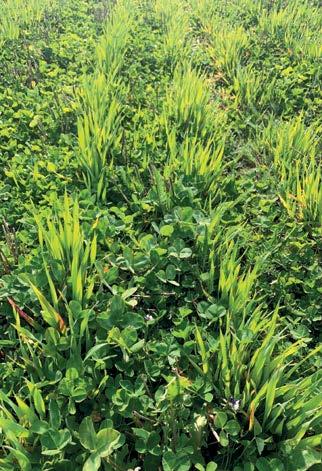
DRILL MANUFACTURERS
IN FOCUS...

Direct Driller Magazine hears from Theo Leeb about the advantages of pulse nozzles and the success of other innovations that, after their launch at Agritechnica, successfully stood their test in the field.

Theo Leeb
DD: Let’s look back on the past year. There were a lot of innovations. How did they settle in the market? Theodor Leeb: The big highlights we presented were the tandem sprayer Leeb 12 TD, the new self-propelled sprayer line PT and our PrecisionSpray with the pulse nozzle technology. DD: Many will already know about the Leeb 12 TD and the new self-propelled sprayer line. Can you give us an update how the machines performed in the field? Theodor Leeb: Let’s start with the tandem sprayer 12 TD. Right at the beginning we thought that it would be a niche product. An important product, but still a niche product for customers with specific requirements with regard to efficiency and logistics. With a large tank capacity, you want to increase the hectare output and ease the logistic problem in case of large distances between the farm and the fields. But the real demand was an absolutely positive surprise. The new product settled in the market in a very short time and is well accepted. This surely is due to the twotank system that solved the challenge with regard to tandem sprayers in a new and innovative way. The total capacity is 12,000 litres divided in 7,000 litres at the front and 5,000 litres at the rear. When spraying both tanks are emptied step by step in such a way that there always is more mixture in the front tank than in the rear one. This technology has proven its worth in hilly terrain as there always is enough vertical load on the tractor. Thus, traction is improved significantly. The customers are very surprised by the low horsepower requirement of the 12 TD. DD: At Agritechnica, the Leeb PT was presented as the basis for a self-propelled sprayer line that HORSCH will launch all over the world. After the successful introduction of the new Leeb PT, the first Leeb VL (Variable Large) has already worked in various markets. What are the first experiences? Theodor Leeb: First of all, we are extremely satisfied with the first serial year of the PT. The feedback we got from our customers, mainly from Central Europe, was very positive. The Leeb VL is a new self-propelled sprayer version for the global market that this year was presented for the first time at an exhibition in Russia and in the meantime has worked several thousand hectares, for example in Eastern Europe. The Leeb VL is equipped with telescopic axles and a new individual wheel suspension. The variably adjustable track width is available with two ranges – between 2.60 and 3.50 m and from 3 to 4 m. Both can be equipped with an optional height adjustment of up to 2 m. To begin with the Leeb VL will be available with a tank capacity of 6,000 l and 8,000 l – and later also with 4,000 l. From the track width you can see that these sprayers are intended for the export markets. Moreover, with the VN (Variable Narrow) line we will launch a version for Europe that also disposes of a variably adjustable track width. There also are two ranges: from 1.80 to 2.25 m or from 2.25 to 3 m. The customer can choose the version that suits him best. As an option, the track adjustment from 2.25 to 3 m can be equipped with a height adjustment
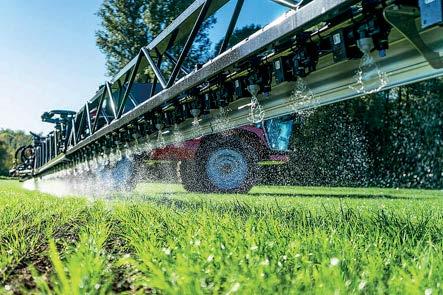
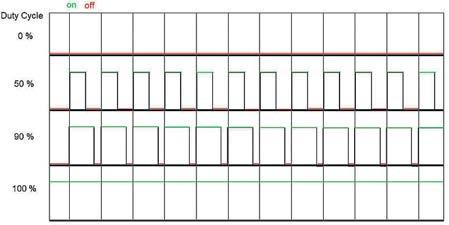
Illustration of the Duty Cycle option.
of up to 2 m. The Leeb VN will be available with a tank capacity of 5,000 l or 6,000 l and with regard to the range of application reminds one a little bit of the Leeb PT 350. DD: For quite a long time HORSCH did not offer an individual nozzle switch-off. Why? Theodor Leeb: Frankly speaking, the technical additional effort was out of all proportion to the benefit as we had a very finely graduated section control with up to 42 sections. DD: But the technical effort for a pulse system like you presented at Agritechnica must not be underestimated either. Theodor Leeb: That’s right. But the additional benefit due to a significantly larger working range of the nozzle, the independence of pressure and thus of drop size and operational speed as well as curve compensation or Variable Rate per section absolutely justify this effort. The demand is enormous. And the feedback on the machines that are working in the field at the moment are extremely positive. No-one would return to the previous system. Quite the contrary. There is no discussion at all. But let’s talk about the advantages one after another. DD: Which requirements that now turned out to have so many advantages were the trigger that made you deal with the pulse nozzles as a hardware and PrecisionSpray as the intelligent HORSCH control system behind it in the first place? Theodor Leeb: It originally resulted from the dilemma of the North American farmers who wanted to go very fast with only one nozzle. It was not possible to cover the desired speed range from 5 km/h to 25 km/h with one nozzle calibre. And this is why the first developments in this sector started in the US. The pulse width modulation is a system that for a start can open and close nozzles at high-frequency. This is carried out via a small electromagnet that by means of an oscillating metal piston opens and closes a borehole. The so-called Hertz number indicates the opening and closing frequency. Our system for example works with 20 Hertz, i.e. the nozzles opens closes 20 times in one second. One cycle (nozzle opens and closes) takes 0.05 seconds. The high frequency is important to guarantee a sufficiently accurate longitudinal distribution. Higher frequencies, however, would make little sense as in this case the adjustment range of the Duty Cycle would be limited. DD: Now you mention another term that is important for the further understanding and the functioning: Duty Cycle. What exactly is it? Theodor Leeb: The system can adapt the opening and closing duration as a percentage dependence of the cycle time. This is the so-called Duty Cycle. The Hertz number of a system indicates the frequency how often a nozzle can be opened and closed in one second, and the Duty Cycle indicates how many percent of an interval is opened. With a Duty Cycle of 0 % the nozzle is closed. With 50 % the nozzle is open during one half of the cycle time and closed during the other half. With a Duty Cycle of 100 % the nozzle would always be open, and you would work like with a conventional plant protection sprayer. We can control the application rate steplessly via different Duty Cycles and, thus, opening times independent of the spraying pressure. A reasonable working range for the Duty Cycle is 30 - 100 %. This means that the output of a nozzle can be reduced to 30 % by the pulse width modulation (PWM) – while the pressure and thus the drop spectrum is kept up. An example: If a 05 nozzle is mounted, the output of a 015 nozzle can be achieved with a Duty Cycle of 30 %. This results in a working range between 015 and 05 – and all that infinitely variable. This illustrates that with the PWM system we basically use larger nozzle calibres and therefore do no longer have any clogging problems. So much for the functioning and the terms.
But that is virtually an individual nozzle control. Theodor Leeb: That’s right. But the advantages of our system are striking. The individual nozzle control a lot of people dwell on actually is only one aspect. Due to the numerous practical experiences our focus is on completely other arguments that are far more practice-oriented.
At any rate, for the farmers it is an innovative technology which prepares them perfectly for the future. For who knows which regulations the legislators all over the world will introduce in the plant protection sector in the future. DD: You already mentioned that the farmer will only have one nozzle that will no longer clog. Theodor Leeb: Yes, you do no longer have to hold a lot of nozzles available like before to always have the appropriate set at hand for any application rate and operational speed. On the other hand, the spraying characteristics are no longer influenced by changing nozzles. That means: Regardless of changing operational speeds or different application rates, the application quality and the cover pattern always remain constant as the adaption to the operational speed is no longer made via the pressure but via the Duty Cycle. The pressure and the drop spectrum remain constant. If the operational speed or the application rate increases, the nozzles do no longer have to be adapted. With the pulse width modulation this is carried out automatically by changing of the Duty Cycle.
In short, the advantages are:
• Infinitely variable adaption of the volume flow while the pressure and the drop size remain constant
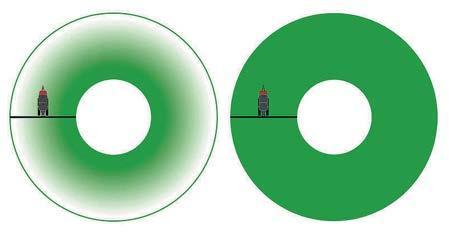
Visualisation of the advantages of curve compensation when using the PrecisionSpray pulse nozzles
• Constant drop spectrum when using one nozzle -> few different nozzle calibres are required • Curve compensation • VariableRate with graduation to virtual 3-meter sections • Individual nozzle switch-off for SectionControl We already know the term curve compensation from the Maestro single grain seed drills. When cornering with large working widths the sowing density on the inside of the curve is reduced and on the outside it is increased. Theodor Leeb: The same principle applies in plant protection and we tackle a very concrete arable problem: The problem of resistant weeds has increased considerably. The weeds often grow from the field boundaries into the population. The problem is that this often is where you have to corner and because of the different speeds of the outside and the inside of the boom an overdose or an underdose may occur. This can be compensated via the curve compensation. With PrecisionSpray the application rate of every nozzle is adapted to the curve speed via the whole boom and thus an exact application with a constant active agent amount is achieved. DD: You can cover everything with one single nozzle. But which nozzle is the right one? Or does it work with all nozzles? Theodor Leeb: Basically: The longer a nozzle and the larger the air chamber is, the more acute is the risk that the liquid impulses are damped and the nozzle starts to „spit“. Most of the short bubblejet nozzles, however, work very well. In North America, where pulse width modulation has already been used for about 20 years, the farmers mainly use standard flat jet nozzles or special low drift nozzles. But here in Germany, they are either not allowed or do not comply with the 90-% drift class. To be able to give a recommendation, we carried out our own tests in the laboratory and in the field with 90%-nozzles as well as with double flat jet nozzles. From a technical point of view these nozzles from the manufacturers Lechler, Agrotop
and Teejet work excellently with our PrecisionSpray. The question that still is unanswered is: Does a 90-% nozzle also comply with the 90% drift class with a PWM system? To answer this question, we are working at full blast the nozzle with manufacturers and the Julius-Kühn-Institute on a corresponding registration. We expect the first results for Germany at the beginning of 2021. Our PrecisionSpray system has already been acknowledged by the JuliusKühn-Institute with regard to reliability, practical suitability and accuracy of the cross distribution. There are technical possibilities to comply with the current stipulations for customers who already have a PWM system. For if you use a Duty Cycle of 100 %, the nozzle behaves like in a standard plant protection sprayer and the current 90-% registration apply. Thus, you can rely on PrecisionSpray already today without having to worry that you might violate applicable stipulations. DD: At Agritechnica, in addition to PrecisionSpray you also exhibited a system to monitor the nozzles. What are your experiences in this sector? Theodor Leeb: You are talking about our NozzlePlugControl - a system that consists of small radar sensors that are mounted in front of the nozzle bodies. To guarantee the practical suitability, we tested several machines with this sensor system in the field during the past season. The tests were very successful. The sensor primarily monitors the area behind the machine which is difficult to see for the driver. The special feature is that our sensor really analyses the quality
of the spraying fan and the spraying pattern and thus offers more than a mere flow control. It often happens that a little contamination disturbs the formation of the spraying fan, but the output quantity still is ok. Thus, this option does not only guarantee maximum operational reliability, but also takes some workload off the driver. Our NozzlePlugControl (NPC) will soon be available for our selfpropelled sprayers as well as for the LT, GS and TD lines.
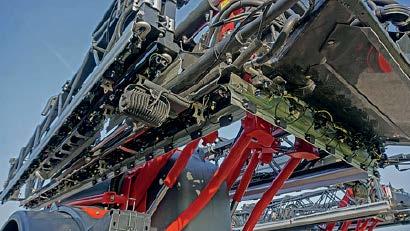
NPC Nozzle Plug Control sensors monitor the nozzle cones.










